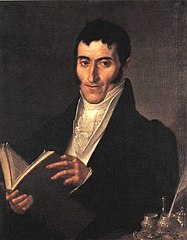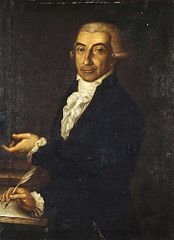Nikolaos Koutouzis
Nikolaos Koutouzis | |
|---|---|
 Self-portrait | |
| Born | 1741 Zakynthos |
| Died | July 23, 1813(1813-07-23) (aged 71–72) Zakynthos |
| Education | Apprentice to Nikolaos Doxaras Apprentice to Giovanni Tiepolo |
| Movement | Heptanese School Neoclassicism Greek Rococo |
Nikolaos Koutouzis, or Koutousis (Greek: Νικόλαος Κουτούζης; 1741 – 1813) was a Greek painter, poet and priest. He was part of the Heptanese School, but also a member of the Modern Greek Enlightenment in art. His teacher was the painter Nikolaos Doxaras. Koutouzis has 136 paintings attributed to him. He was one of the last Greek painters to incorporate the Venetian style during its decline, due to the Fall of the Republic of Venice. He was the teacher of Nikolaos Kantounis, who was heavily influenced by his style.[1][2][3]
Biography

He was born in a part of Greece that was under Venetian, rather than Ottoman control. He appears to have taken his first art lessons from Nikolaos Doxaras,[4] who lived on Zakynthos during the 1750s. At the age of sixteen, under his direction, Koutouzis painted decorations at the Churches of Saint John of Damascus and Saint Demetrius, both of which have since been destroyed. He may have lived in Venice from 1760 to 1764, and been apprenticed to Giovanni Tiepolo.[5] If so, he was definitely back at Zakynthos in 1766, painting the "Procession of Saint Dionysius".
He also wrote satirical poems on local affairs and scandals,[4] which often contained sharp lampoons of his contemporaries. In 1770, this led to an assault, during which he was wounded in the face.[5] To hide the scar, he grew a beard. This event is also cited as his reason for becoming a priest, but it was seven years later before he took up priestly duties on Lefkada. He subsequently became a parish priest at several locations on his native island.
Nevertheless, he continued to write satirical poetry. This, combined with what was considered a theatrical manner of conducting church services, led to clashes with his superiors and parishioners. Eventually, he was charged with "misconduct and violation of the Orthodox ritual" and was defrocked in 1810.[6][7] Three years later, some of his accusers recanted and he was reinstated but refused to take up his duties. He died a few months later. Although he focused on religious painting, his portraits were better known during his lifetime. He also took in the occasional student, most notably Nikolaos Kantounis.[5]
Gallery
-
 Portrait of a Scholar
Portrait of a Scholar -
 Adoration of the Magi
Adoration of the Magi -

-

-
 Portrait of a Nobleman
Portrait of a Nobleman
with a Wig -
 Saint Spyridon, Saint John the Baptist, Saint Peter and Saint George
Saint Spyridon, Saint John the Baptist, Saint Peter and Saint George
References
- ^ Hatzidakis, Manolis & Drakopoulou, Eugenia (1997). Greek painters after the fall (1450-1830) Volume B. Center for Modern Greek Studies E.I.E. pp. 120–124.
- ^ Speake, Graham (2021). Encyclopedia of Greece and the Hellenic Tradition By Vasilios Makrides. London And New York: Rutledge Taylor & Francis Group. p. 1228. ISBN 9781135942069.
- ^ Eugenia Drakopoulou (July 21, 2021). "Koutouzis (Kotouzis, Kotouzios, Cottusi) Nikolaos". Institute for Neohellenic Research. Retrieved July 21, 2021.
- ^ a b Brief biography @ Ygeia Online
- ^ a b c Brief biography Archived 2014-03-05 at the Wayback Machine @ the National Gallery website
- ^ Staff Writers (July 21, 2021). "Kantounis Nikolaos". National Gallery of Greece. Retrieved July 21, 2021.
- ^ Hatzidakis, 1997, pp 121-124
Further reading
- Nikolaos Koutouzis, Βωμολοχικές σάτιρες ιερέων, (satirical poems) Periplus, 1996 ISBN 978-960-7131-42-3
- Dinos Konomos, Nikolaos Koutouzis (a biographical novel), Athens, A.Karavias, 1974 [1]
External links

- Biographical notes, with samples of his poetry, @ the Imera (Zante edition) website
- v
- t
- e
- The Archangel Michael (Poulakis, 1640–1692)
- Constantine and Helen (I. Moskos, 1665–1721)
- The Fall of Man (Poulakis, 1640–1692))
- The Holy Towel (E. Tzanes, 1659))
- Saint Onuphrius (E. Tzanes, 1662))
- Jacob’s Ladder (E. Moskos, 1664–1666)
- The Miracle of the Holy Belt (Poulakis, 1640–1692))
- Virgin and Child on Bronze (E. Moskos, 1650–1687)
- Noah's Ark (Poulakis, 1660–1692)
- Adoration of the Shepherds (Tzangarolas, 1688–1700)
- Virgin Glykofilousa with the Akathist Hymn (Tzangarolas, 1700)
- The Holy Family (P. Doxaras, 1700)
- Virgin Glykofilousa (Karantinos, 1723)
- Angel Holding the Body of Christ (Kallergis, 1732)
- Vision of Constantine (Stavarkis, 1729–1786)
- Assumption of Mary (N. Doxaras, 1725–1775)
- The Prophet Jonah (Stavrakis, 1750–1800)
- The Deposition from the Cross (Stavrakis, 1729-1786)
- The Holy Trinity (Romas, 1764)
- Entry of Christ into Jerusalem (Karousos, 1780)
- A Scene from the Life of John Chrysostom (Ventouras, 1797)
- Saint Spyridon, John the Baptist, Saint Peter, and Saint George (Koutouzis, 1750–1813)
- Lamentation of Christ (Kantounis, 1790–1834)















